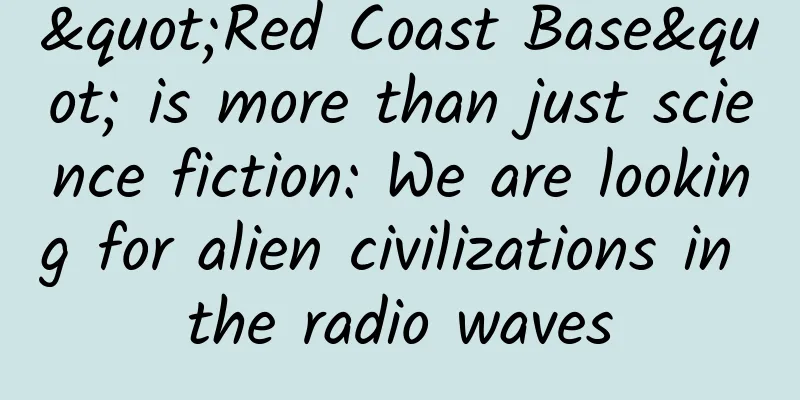"Red Coast Base" is more than just science fiction: We are looking for alien civilizations in the radio waves

|
"Red Coast Base" is more than just science fiction: We are looking for alien civilizations in the radio waves The "real and imaginary" Red Coast Base in the TV series "The Three-Body Problem" is not entirely fictional. In reality, astronomers have been trying to make contact with extraterrestrial civilizations decades ago... "Whenever it's late at night and everyone is asleep, I always stay alone in the empty monitoring room. The headphones are filled with the lifeless noise of the universe. That noise is vague and seems to be more eternal than the stars. Sometimes I feel that the sound is like the endless cold wind on the radar peak, which makes me feel very cold. That kind of loneliness is really indescribable." ——Ye Wenjie (character in "The Three-Body Problem") Recently, the TV series "The Three-Body Problem", adapted from Liu Cixin's science fiction novel of the same name, was broadcast, sparking heated discussions among science fiction fans. Based on the basic context of the original work, the series uses concrete film and television language to present the world of "The Three-Body Problem" to the audience in a relatively complete manner, which has made many fans of the original work very excited. Among them, the series's precise portrayal of the "Red Coast Base" scene is particularly amazing—— The towering radar peak in the wind and snow, the slowly rotating huge radio antenna, the soldiers shuttling back and forth in the base...when high-energy electromagnetic waves were launched into the air, the wind and clouds around suddenly changed, the ice and snow melted instantly, and flocks of birds fell to the ground, giving the audience the illusion that "the Red Bank Project really existed." ▲The huge radio antenna of the Red Coast Base that appeared in the TV series "The Three-Body Problem" (Image source: TV series "The Three-Body Problem") In Liu Cixin's Three-Body World, the "Red Bank Base" is a top-secret national defense project carried out by my country to explore extraterrestrial civilizations. The base has a huge radio antenna that transmits information about the earth to outer space by regularly emitting high-power electromagnetic waves, while also monitoring radio wave information from deep space around the clock. Although the Red Bank Base is only a fiction in science fiction, in the real world, exploring extraterrestrial civilizations is not a new topic - the search for extraterrestrial civilizations using electromagnetic waves has been going on for decades. Are humans really lonely? Are humans the only intelligent life in the vast universe? This question has constantly stimulated the imagination of pioneers since the beginning of human exploration of the universe. When people could only use simple optical instruments to observe celestial bodies in the solar system, some people boldly speculated that perhaps on Mars, Venus and some more distant planets, there are intelligent creatures similar to humans. However, with the rapid growth of human scientific research capabilities, the possibility of "life on other planets in the solar system" has gradually returned to zero - the Earth is really the only existence in the solar system! In this case, can other star systems outside the solar system breed life and even develop advanced civilizations? Today we know that the solar system that breeds life and civilization is just a "passerby" in the universe. In the 1950s, American physicist Fermi put forward the view that there are about 250 billion stars in the Milky Way alone, and the scale of stars in the entire universe is even greater. Even if the probability of the emergence of intelligent life is extremely low, considering the huge number of stars, there should be a large number of alien civilizations in the vast universe. ▲The 66-meter deep space exploration station in Jiamusi is considered to be one of the prototypes of the "Red Bank Base". The exploration station has participated in China's lunar exploration projects many times (Photo source: China Military Network) "The exploration of extraterrestrial life can be divided into several levels and stages. The first is to explore extraterrestrial planets; the second is to explore whether there is life on these planets; and then to explore whether these lives can develop into civilized forms." Li Ran, a researcher at the National Astronomical Observatory of the Chinese Academy of Sciences, explained to reporters. The universe is vast, how do we explore distant exoplanets? The answer is given in The Three-Body Problem - in addition to the visible light emitted by stars, there are also radio waves emitted by celestial bodies in the universe. These radio waves, which are invisible to the naked eye, contain a vast amount of information in the universe. Listening to the depths of space The radio telescopes that humans began to develop in the 1930s broke through the limitations of traditional optical telescopes. Since they are less affected by light and climate, radio telescopes can "look up at the stars" all day and night and collect radio information from the universe. The radio astronomy that was born from this has greatly expanded the depth of human understanding of the universe. The huge parabolic antenna is a typical feature of radio telescopes. The Arecibo telescope built in the United States in the last century and the FAST telescope built in my country in 2016 are both leaders in radio telescopes. With the help of radio telescopes, scientists can receive electromagnetic waves from distant stars, pulsars, quasars and other celestial bodies as well as cosmic background radiation. Of course, in theory, they can also receive information sent by alien civilizations. "In the beginning, the astronomical community used radio telescopes to study radio radiation in the universe. If alien life develops a highly developed civilization like humans on Earth, they will have the need to communicate and the ability to send radio signals to the universe. Theoretically, with the help of radio telescopes, we may be able to passively receive information from alien civilizations," said Li Ran. Therefore, radio astronomy began to be applied to the exploration of extraterrestrial civilizations more than 20 years after its birth. In 1960, American astronomer Frank Drake organized the ambitious "Ozma Project", using a 26-meter radio telescope in West Virginia to search for signals from extraterrestrial civilizations near the solar system - this was the first time in human history that radio telescopes were used in an organized manner to explore extraterrestrial civilizations. ▲The "Ozma" project uses the 26-meter radio telescope of the Green Bank Observatory in the United States to monitor messages from extraterrestrial civilizations (Image source: National Radio Astronomy Observatory) In the TV series "The Three-Body Problem", the main body of the Red Coast Base is a typical radio telescope, and its huge parabolic antenna can be rotated to different observation areas as needed. In the monitoring room of the base, Ye Wenjie listens to the radio information in the universe like the chirping of cicadas day and night. In reality, astronomers launched the second phase of the "Ozma Project" in 1972. They expanded the detection channels and range of the radio telescope and monitored more than 600 stars within 80 light years of the Earth for several years, but found nothing. "There are two major difficulties in this type of exploration: one is that the radio telescope must be large enough and have strong enough detection capabilities; the other is to distinguish from the received radio signals which are signals from celestial bodies and which are signals from extraterrestrial civilizations." Li Ran said. The scientists of the "Ozma" project obviously overestimated the probability of monitoring signals from alien civilizations. The real world is always much more complicated than the theoretical promotion on paper. "There are hundreds of billions of stars in the Milky Way. It is difficult to judge how many of these star systems may have intelligent life. It is extremely difficult to conduct deep radio observations of all star systems. No country can currently do this kind of engineering work." Calling the Universe In addition to passive monitoring, humans have also tried to actively send radio signals to the universe. In addition to the monitoring department, another important part of the Red Bank Base in "The Three-Body Problem" is the transmission department. In the TV series, the Red Bank Base regularly sends signals to the universe: high-power electromagnetic waves pierce the clouds on the top of the mountain, even causing disturbances in the atmosphere, and the nearby ice and snow melted rapidly... In reality, humans have sent information to different locations in space 12 times. Among them, the first person to "take the plunge" was Frank Drake. In 1974, the Arecibo radio telescope in Puerto Rico had just completed its transformation. Drake proposed to use the telescope's three transmitters to actively send radio signals to extraterrestrial galaxies in the hope that extraterrestrial creatures with advanced civilizations could receive them. On November 16 of that year, Drake's team sent a 169-second radio signal to the Hercules globular cluster M13, 25,000 light-years away from Earth. ▲In October 2020, the Arecibo telescope collapsed (Photo source: Science) This "call" sent by humans to deep space has a power of 450 kilowatts. On the huge scale of the Milky Way, this is really insignificant. Soviet astronomer Nikolai Kardashev once divided the levels of civilization according to the power that can be used for communication. Among them, the lowest type I civilization can dispatch energy equivalent to the output power of the entire earth for communication, and its order of magnitude is about 1016 watts. In comparison, relying on a mere 450 kilowatts of power to transmit information about the earth to alien civilizations, is this a fantasy? "Although electromagnetic wave signals attenuate with distance, they will not disappear completely. Whether they can be received does not depend entirely on the transmission power, but also on the receiving ability of the alien civilization." Li Ran explained. In "The Three-Body Problem", Liu Cixin used a lot of creative ideas to rationalize the setting of "humans establishing communication with aliens", such as letting Ye Wenjie accidentally discover that the sun can be used as a radio wave amplifier, and by sending radio waves to the sun, stronger signals can be sent to other star systems. "But this is a science fiction setting that meets the needs of the plot, and it doesn't work in reality. Sending radio waves to the sun cannot produce the effect in the novel." Li Ran said. ▲Ye Wenjie working in the monitoring room in the TV series "The Three-Body Problem" (Image source: TV series "The Three-Body Problem") For example, in order to enable smooth communication between humans and aliens, Ye Wenjie was also ordered to create a radio information self-decoding system. She used the basic mathematical and physical principles that are "universal" to establish a basic language meta-code system. Civilizations that can understand basic mathematical principles can quickly decipher and understand the received information. But in Li Ran's opinion, images are the best way to communicate with another kind of intelligent life. "Alien civilizations may find information that can be directly understood from images, such as the appearance of a celestial body, the outline of a life form, etc." The Arecibo message that is still flying in the universe is a few simple patterns composed of 1679 binary digits, including key information such as numbers, DNA elements, human appearance, and the composition of the solar system. Compared with the current technological level of mankind, the self-decoding system envisioned in "The Three-Body Problem" is still a bit too imaginative. ▲Radio signals sent into space by the Arecibo telescope in 1974 (Photo source: www.fuseworks.it) In fact, from the initial "Ozma" project and the "One-Eyed God" project to the later "Arecibo Message", HRMS project, "Cosmic Calling" project and "Phoenix" project, humans have been using radio telescopes to explore extraterrestrial civilizations for more than 60 years, but so far, we have not found any traces of extraterrestrial civilizations. Will humans' high-profile attempts to establish contact with extraterrestrial civilizations pose a huge threat to themselves, as Hawking warned before his death or as described in the "Dark Forest" theory in "The Three-Body Problem"? We don't know whether the plot of "Don't Answer" will become a reality, but the boundaries of human cognition of the universe will continue to expand in the future. |
<<: Super bacteria, the "devil of the world" raised by humans
>>: The top ten evolutionary "weirdos" in nature, each one more outrageous than the other (Part 1)
Recommend
Breaking the record! Shenzhou 15 crew completes fourth extravehicular activity
The reporter learned from the China Manned Space ...
How to build an online promotion and operation system from scratch?
Nine-word operation policy Visual hammer: forming...
How to prepare the 2016 annual report? How to make a marketing promotion and operation plan in 2017?
2016 Annual Report Guidelines 1. Overall operatio...
Android multi-process communication - in-depth understanding
[[405775]] 1. What is multi-process? Normally, in...
A Guide to Hard-core Influencer Branding
There is no brand that doesn’t want to become a h...
She replaced Musk, and the position of Tesla chairman was officially replaced
According to foreign media reports, Tesla said th...
How to use YouTube to attract traffic? Practical YouTube traffic generation tips
Written at the beginning: I believe everyone has ...
How did Zhihu/Mafengwo/Boss Zhipin promote themselves during the World Cup?
Today, we will share from a practical operation p...
How to choose Wenchang Tower?
1. First of all, the jade Wenchang Tower has the ...
Huawei Mate 20 Pro returns to the Android Q list
Today, foreign media discovered that the Mate 20 ...
Guoxuan High-tech is transferring its lithium battery technology to India. Isn’t it afraid of being legally “robbed” like vivo?
Industrial transfer has been a hot word in recent...
Apple Pay's most practical function has been released. Can it be used to defeat WeChat and Alipay?
Even though my iPhone had automatically updated t...
Who says Amazon is the only tech company? See how JD.com’s “Shuhai” shows off its tech style
From powerful warehouse management systems to ima...
AIIA: 2021 White Paper on Artificial Intelligence Applications in the Telecommunications Industry
In order to accelerate the application and integr...
Cool horizontal elastic menu
Source code introduction: MySpringMenu is a cool ...
![Quickly create blockbuster film and television clips of the explosive level, with 100,000+ data for a single work [Video Course]](/upload/images/67cc306121ffb.webp)








